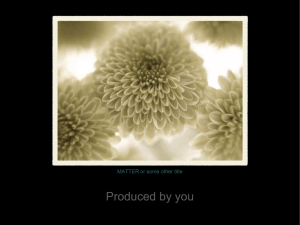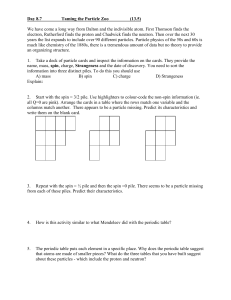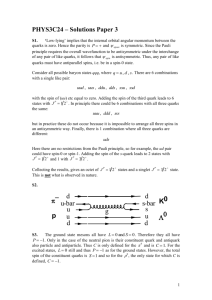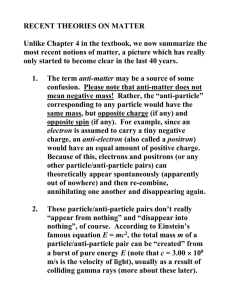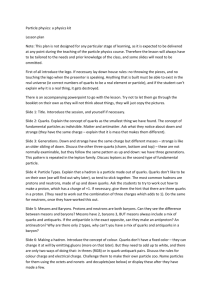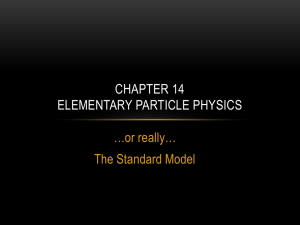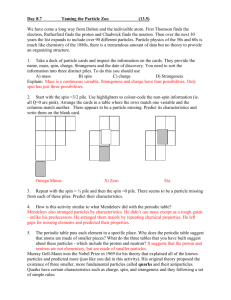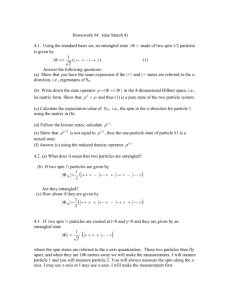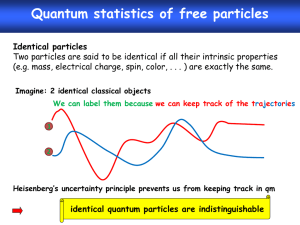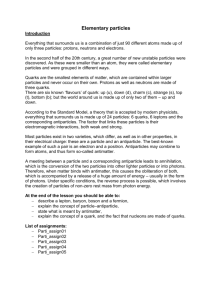Gotta Know Supreme Court Cases
advertisement
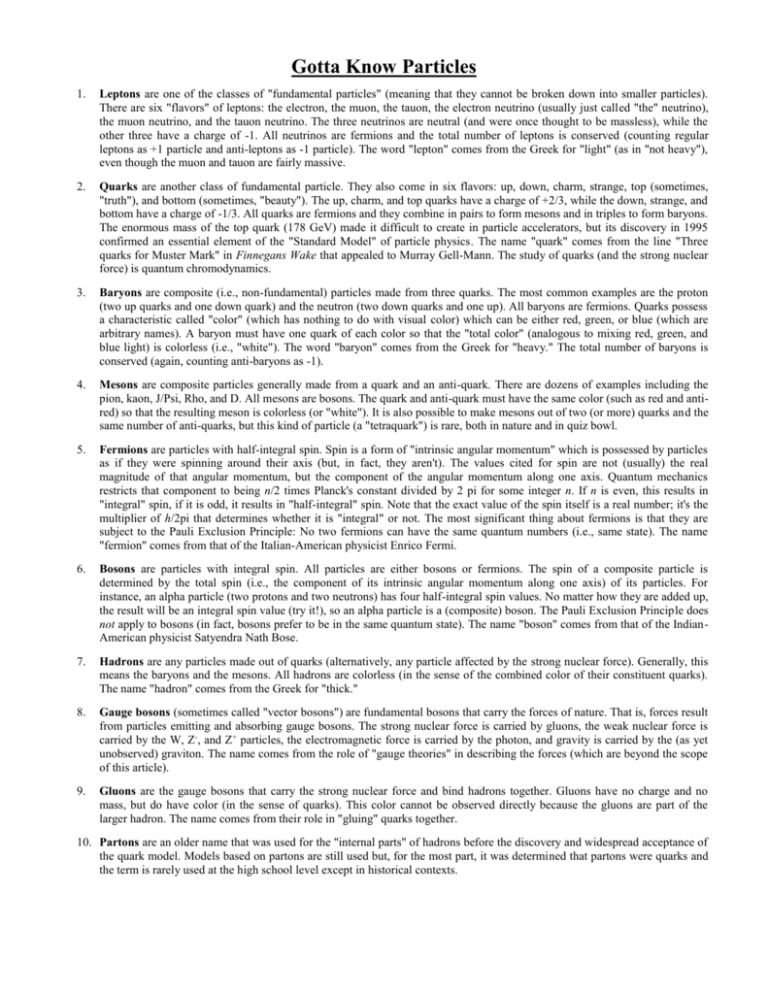
Gotta Know Particles 1. Leptons are one of the classes of "fundamental particles" (meaning that they cannot be broken down into smaller particles). There are six "flavors" of leptons: the electron, the muon, the tauon, the electron neutrino (usually just called "the" neutrino), the muon neutrino, and the tauon neutrino. The three neutrinos are neutral (and were once thought to be massless), while the other three have a charge of -1. All neutrinos are fermions and the total number of leptons is conserved (counting regular leptons as +1 particle and anti-leptons as -1 particle). The word "lepton" comes from the Greek for "light" (as in "not heavy"), even though the muon and tauon are fairly massive. 2. Quarks are another class of fundamental particle. They also come in six flavors: up, down, charm, strange, top (sometimes, "truth"), and bottom (sometimes, "beauty"). The up, charm, and top quarks have a charge of +2/3, while the down, strange, and bottom have a charge of -1/3. All quarks are fermions and they combine in pairs to form mesons and in triples to form baryons. The enormous mass of the top quark (178 GeV) made it difficult to create in particle accelerators, but its discovery in 1995 confirmed an essential element of the "Standard Model" of particle physics. The name "quark" comes from the line "Three quarks for Muster Mark" in Finnegans Wake that appealed to Murray Gell-Mann. The study of quarks (and the strong nuclear force) is quantum chromodynamics. 3. Baryons are composite (i.e., non-fundamental) particles made from three quarks. The most common examples are the proton (two up quarks and one down quark) and the neutron (two down quarks and one up). All baryons are fermions. Quarks possess a characteristic called "color" (which has nothing to do with visual color) which can be either red, green, or blue (which are arbitrary names). A baryon must have one quark of each color so that the "total color" (analogous to mixing red, green, and blue light) is colorless (i.e., "white"). The word "baryon" comes from the Greek for "heavy." The total number of baryons is conserved (again, counting anti-baryons as -1). 4. Mesons are composite particles generally made from a quark and an anti-quark. There are dozens of examples including the pion, kaon, J/Psi, Rho, and D. All mesons are bosons. The quark and anti-quark must have the same color (such as red and antired) so that the resulting meson is colorless (or "white"). It is also possible to make mesons out of two (or more) quarks and the same number of anti-quarks, but this kind of particle (a "tetraquark") is rare, both in nature and in quiz bowl. 5. Fermions are particles with half-integral spin. Spin is a form of "intrinsic angular momentum" which is possessed by particles as if they were spinning around their axis (but, in fact, they aren't). The values cited for spin are not (usually) the real magnitude of that angular momentum, but the component of the angular momentum along one axis. Quantum mechanics restricts that component to being n/2 times Planck's constant divided by 2 pi for some integer n. If n is even, this results in "integral" spin, if it is odd, it results in "half-integral" spin. Note that the exact value of the spin itself is a real number; it's the multiplier of h/2pi that determines whether it is "integral" or not. The most significant thing about fermions is that they are subject to the Pauli Exclusion Principle: No two fermions can have the same quantum numbers (i.e., same state). The name "fermion" comes from that of the Italian-American physicist Enrico Fermi. 6. Bosons are particles with integral spin. All particles are either bosons or fermions. The spin of a composite particle is determined by the total spin (i.e., the component of its intrinsic angular momentum along one axis) of its particles. For instance, an alpha particle (two protons and two neutrons) has four half-integral spin values. No matter how they are added up, the result will be an integral spin value (try it!), so an alpha particle is a (composite) boson. The Pauli Exclusion Principle does not apply to bosons (in fact, bosons prefer to be in the same quantum state). The name "boson" comes from that of the IndianAmerican physicist Satyendra Nath Bose. 7. Hadrons are any particles made out of quarks (alternatively, any particle affected by the strong nuclear force). Generally, this means the baryons and the mesons. All hadrons are colorless (in the sense of the combined color of their constituent quarks). The name "hadron" comes from the Greek for "thick." 8. Gauge bosons (sometimes called "vector bosons") are fundamental bosons that carry the forces of nature. That is, forces result from particles emitting and absorbing gauge bosons. The strong nuclear force is carried by gluons, the weak nuclear force is carried by the W, Z-, and Z+ particles, the electromagnetic force is carried by the photon, and gravity is carried by the (as yet unobserved) graviton. The name comes from the role of "gauge theories" in describing the forces (which are beyond the scope of this article). 9. Gluons are the gauge bosons that carry the strong nuclear force and bind hadrons together. Gluons have no charge and no mass, but do have color (in the sense of quarks). This color cannot be observed directly because the gluons are part of the larger hadron. The name comes from their role in "gluing" quarks together. 10. Partons are an older name that was used for the "internal parts" of hadrons before the discovery and widespread acceptance of the quark model. Models based on partons are still used but, for the most part, it was determined that partons were quarks and the term is rarely used at the high school level except in historical contexts.
